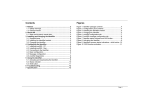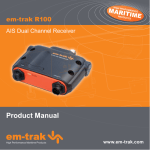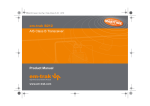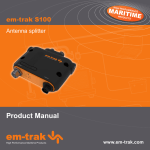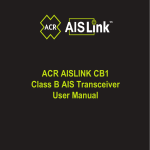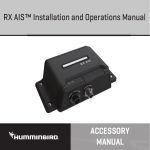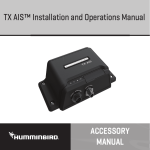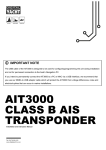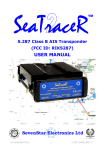Download I100 User Manual - em-trak
Transcript
MARI TIME HIGH P em-trak I100 E R FO R PRO D MANC E UCTS Product configuration manual High Performance Maritime Products www.em-trak.com Contents List of Figures 1 - Notices ................................................................................. 2 1.1 - Safety warnings.................................................................. 2 1.2 - General notices .................................................................. 2 2 - About AIS............................................................................. 3 2.1 - Static and dynamic vessel data.......................................... 4 3 - Installing and charging the Identifier ................................ 5 3.1 - Supplied items.................................................................... 5 3.2 - Installing the Identifier bracket ........................................... 7 3.3 - Charging the Identifier........................................................ 8 4 - Configuring the Identifier ................................................... 9 4.1 - Installing proAIS2 - PC....................................................... 9 4.2 - Installing proAIS2 - Mac ..................................................... 9 4.3 - Connecting to the Identifier ................................................ 9 4.4 - Basic configuration........................................................... 10 4.5 - Message configuration ..................................................... 11 4.6 - proAIS2 diagnostics ......................................................... 13 5 - Using the Identifier............................................................ 14 5.1 - Activating and deactivating the Identifier.......................... 15 5.2 - Status indicator ................................................................ 16 5.3 - SOS button....................................................................... 18 6 - Troubleshooting................................................................ 19 7 - Specification...................................................................... 20 Figure 1 - Identifier package contents ........................................ 5 Figure 2 - Configuration pack contents....................................... 6 Figure 3 - Installing the Identifier bracket ................................... 7 Figure 4 - Charging the Identifier................................................ 8 Figure 5 - proAIS2 configuration tab......................................... 11 Figure 6 - proAIS2 message configuration tab ......................... 13 Figure 7 - Identifier status indicator and SOS button................ 14 Figure 8 - Activating the Identifier............................................. 15 Figure 9 - Identified common status indications - while active . 17 Figure 10 - SOS function activation.......................................... 18 Page 1 Notices 1 Notices ! 1.1 When reading this manual please pay attention to warnings marked with the warning triangle shown on the left. These are important messages for safety, installation and usage of the product. Safety warnings ! This equipment must be installed in accordance with the instructions provided in this manual. ! Do not install this equipment in a flammable atmosphere such as in an engine room or near to fuel tanks. ! Any attempt to tamper with or damage this product will invalidate the warranty. ! This product contains a Lithium-Ion battery. Never expose to fire or high temperatures. Do not attempt to dissasemble the product. Do not short circuit the battery or attempt to charge with equipment other than the supplied charger. 1.2 General notices Position source All marine Automatic Identification System (AIS) transceivers utilise a satellite based location system such as the Global Positioning System (GPS) network. The accuracy of a GPS position fix is variable and is affected by factors such as the antenna positioning, how many satellites are used to determine a position and for how long satellite information has been received for. RF emissions notice Caution: The AIS transceiver generates and radiates radio frequency electromagnetic energy. This equipment must be installed and operated according to the instructions contained in this manual. Failure to do so can result in personal injury and / or AIS transceiver malfunction. Accuracy of this manual The AIS transceiver may be upgraded from time to time and future versions of the AIS transceiver may therefore not correspond exactly with this manual. Information contained in this manual is liable to change without notice. The manufacturer of this product disclaims any liability for consequences arising from omissions or inaccuracies in this manual and any other documentation provided with this product. Page 2 About AIS 2 About AIS The marine Automatic Identification System (AIS) is a location and vessel information reporting system. It allows vessels equipped with AIS to automatically and dynamically share and regularly update their position, speed, course and other information such as vessel identity with similarly equipped vessels. Position is derived from the Global Positioning System (GPS) and communication between vessels is by Very High Frequency (VHF) digital transmissions. There are a number of types of AIS device as follows: • Class A transceivers. These are similar to class B transceivers, but are designed to be fitted to large vessels such as cargo ships and large passenger vessels. Class A transceivers transmit at a higher VHF signal power than class B transceivers and therefore can be received by more distant vessels. They also transmit more frequently. Class A transceivers are mandatory on all vessels over 300 gross tonnes on international voyages and certain types of passenger vessels under SOLAS regulations. • Class B transceivers. Similar to class A transceivers in many ways, but are normally lower cost due to the less stringent performance requirements. Class B transceivers transmit at a lower power and at a lower reporting rate than class A transceivers. • AIS base stations. AIS base stations are used by Vessel Traffic Systems to monitor and control the transmissions of AIS transceivers. • Aids to Navigation (AtoN) transceivers. AtoNs are transceivers mounted on buoys or other hazards to shipping which transmit details of their location to the surrounding vessels. • AIS receivers. AIS receivers will generally receive transmissions from class A transceivers, class B transceivers, AtoNs and AIS base stations but do not transmit any information about the vessel on which they are installed. • AIS Identifier. The Identifier is a unique, self-contained AIS vessel tracking device. The key features of the AIS Identifier are as follows: • Self-contained VHF and GPS antennas • Internal rechargeable battery pack for up to 5 days of operation • Electronic security link to vessel mounting bracket • Simple installation Page 3 About AIS 2.1 Static and dynamic vessel data There are two categories of information transmitted by an AIS transceiver: static and dynamic data. The vessel's dynamic data, which includes location, speed over ground (SOG) and course over ground (COG), is calculated automatically using the internal GPS receiver. Static data is information about the vessel which must be programmed into the AIS transceiver. This includes: • Maritime Mobile Service Identity (MMSI) • Vessel name • Vessel call sign (if available) • Vessel type • Vessel dimensions • In most countries the operation of an AIS transceiver is included under the vessel's marine VHF licence provisions. The vessel on to which the AIS unit is to be installed must therefore possess a current VHF radiotelephone licence which lists the AIS system, vessel Call Sign and MMSI number. ! Page 4 An MMSI number is required in order for the AIS transceiver to operate. Please contact the relevant authority in your country for more information. Installing and charging the Identifier 3 Installing and charging the Identifier 3.1 Supplied items Figure 1 shows the items that are included with each Identifier. Note that a configuration dock and PC configuration software are supplied separately in a configuration pack. The contents of the configuration pack are shown in Figure 2. Charger Vessel bracket and fixings Identifier Figure 1 Identifier package contents Identifier The Identifier AIS tracking device. The Identifier is self-contained and incorporates a rechargeable battery pack, VHF antenna and GPS antenna. Charger The charger base is used to recharge the Identifier from an AC mains supply. Page 5 Installing and charging the Identifier Vessel bracket and fixings The vessel bracket is used to attach the Identifier to the vessel. It also automatically switches the Identifier on when installed in the bracket. Product CD Product manual Configuration dock USB Cable Figure 2 Configuration pack contents Configuration dock The configuration dock is used to connect the Identifier to a PC or Mac during configuration. The configuration dock can also be used to charge the Identifier. USB Cable The USB Cable is used to connect the configuration dock to the PC or Mac. CD The CD contains the configuration software and this user manual in PDF format. Product manual This document is the product manual. Page 6 Installing and charging the Identifier 3.2 Installing the Identifier bracket The Identifier must be located in the supplied mounting bracket when in use. Insertion into the bracket activates the Identifier and the Identifier is inactive when removed from the bracket. The bracket should be fixed to the vessel using the supplied u-bolts, washers and nuts as shown in Figure 3. The bracket should be mounted to a non-metallic vertical pole and installed in a location where the status indicator is visible. Ideally the Identifier should be installed approximately 2m above sea level. The area around and above the Identifier should be clear from any obstructions as these may affect GPS reception and / or VHF transmission range. Ensure that the Identifier bracket is installed in the orientation shown in Figure 3. Figure 3 Installing the Identifier bracket Page 7 Installing and charging the Identifier 3.3 Charging the Identifier The Identifier is shipped with a partial charge and requires a full charge prior to installation on a vessel. The Identifier is charged by placing it in the charging dock as shown in Figure 4. During charging the status indicator will flash at a steady rate. When charging is complete the status indicator will stop flashing and remain constantly illuminated. Depending on the condition of the battery a full charge can take up to 5 hours to complete. Note that the Identifier can be configured as described in section 4 prior to charging. 1 2 11 12 3 1 2 10 3 9 4 8 7 Figure 4 ! Page 8 4 6 5 Charging the Identifier The Identifier will not charge if the internal temperature is below 0°C or above 40°C. If the temperature is outside this range the status indicator will flash rapidly to indicate a charging fault. Configuring the Identifier 4 Configuring the Identifier The Identifier transmits standard AIS position and vessel data reports. It requires configuration with the relevant vessel information prior to installation. The Identifier can also be configured for position reporting intervals, VHF operating frequency and other operating parameters listed below. Configuration is carried out from a PC or MAC running the proAIS2 application supplied on CD in the configuration pack. 4.1 1. Installing proAIS2 - PC 2. Insert the CD into your PC or Mac and navigate to the ‘proAIS2’ then the ‘Windows’ folder. Double click the setup.exe file then follow the on-screen prompts. If a security warning appears, click 'Install' to continue with the installation. 4. Once installation is complete, proAIS2 will launch automatically and a start menu folder and shortcut will be created for future use. 5. A detailed user guide for proAIS2 is available via the application help menu. 4.2 Installing proAIS2 - Mac 1. Insert the CD into your Mac, then navigate to the 'proAIS' then the 'OSX' folder. 2. Double click the proAIS2.dmg file then follow the on screen instructions to complete the installation. 4.3 Connecting to the Identifier Connect to the Identifier by inserting it into the configuration dock (supplied in the configuration pack) and connecting the configuration dock USB cable to a PC or Mac. The first time the connection is made the USB drivers must be installed. If automatic installation is not successful the drivers are also provided in a separate folder on the CD supplied in the configuration pack to allow manual installation. Once the drivers are installed, launch the proAIS2 application and select the relevant communications port from the drop down menu. The port will be listed as “USB Serial Port (COMn)” where n is the number of the port. Click the ‘Connect’ button to connect to the Identifier. The ‘Disconnect’ button should be clicked once configuration has been completed and prior to physically disconnecting the Identifier from the PC or Mac. Page 9 Configuring the Identifier 4.4 Basic configuration All basic configuration is presented on the proAIS2 configuration tab as shown in Figure 5. This tab permits configuration of the following information: • Ship’s name Enter the vessel name or other identification. • Call sign Enter the vessel call sign (if available). • MMSI number Enter the vessel’s 9 digit MMSI number. • Vessel type Select the most appropriate vessel type from the drop down list. • Ship’s dimensions Enter the vessel dimensions, referenced to the location of the identifier, to the nearest whole metre. • Reset paired bracket / holder ID Checking this option will reset the pairing of the Identifier to a vessel bracket. The next time the Identifier is placed in a vessel bracket it will be paired with that bracket. See section 5.1 for further information on bracket pairing. • Deep sleep mode Select this option to enable deep sleep mode when the ‘Disconnect’ button is pressed in proAIS2. Deep sleep mode will put the Identifier in a very low power consumption mode suitable for storage or shipping. Deep sleep mode will exit the next time the Identifier is inserted into a charger or configuration dock. • Configuration of AIS operating frequencies Select the required operating VHF frequencies for transmissions. The default channels are Channel A = 161.975MHz and Channel B = 162.025MHz. It is critical that these frequencies match the configuration of any receiving equipment. To save the configuration to the Identifier click the ‘Write Configuration’ button and acknowledge the MMSI programming warning. Page 10 Configuring the Identifier Figure 5 4.5 proAIS2 configuration tab Message configuration All AIS messaging configuration is presented on the proAIS2 Message Configuration tab as shown in Figure 6. This tab permits configuration of the following information: • Message 18 interval below SOG threshold Sets the time in seconds between transmissions of message 18 when the vessel is travelling at a speed below the threshold value. Message 18 contains vessel MMSI, position, course and speed information. • Speed over Ground (SOG) threshold Sets the speed over ground (in knots) at which the Identifier will switch transmission intervals for message 18. There are two transmission intervals; one for speeds below the threshold and one for speeds above the threshold. This parameter sets that speed threshold. Page 11 Configuring the Identifier • Message 18 interval above SOG threshold Sets the time in seconds between transmissions of message 18 when the vessel is travelling at a speed over ground above the threshold speed value. Message 18 contains vessel MMSI, position, course and speed information. • Message 24 and 25 interval Sets the time in seconds between transmissions of messages 24 and 25. Message 24 contains vessel name, call sign, dimensions and vessel type. Message 25 can be configured for transmission if the Identifier is located in a bracket/holder other than its paired bracket/holder. This allows a shore system to locate and identify vessels carrying the wrong Identifier. • SOS message configuration (Message 14) Sets the text transmitted in the Identifier SOS message. Text up to 13 characters in length can be transmitted. By default the text transmitted is set to ‘MAYDAY MAYDAY’. • Message 25 type The Identifier can be configured to transmit message 25 (a binary data message) when operating in a vessel bracket/holder other that its correctly paired bracket/holder. The message type can be configured as disabled (no message is sent), broadcast message transmission (sent to all receivers) or addressed message transmission (sent only to a specific shore station). • Destination MMSI When message 25 is configured for addressed transmission, the MMSI of the destination should be entered here. • Message text The text content for message 25 should be entered here. • Designated area code (DAC) The designated area code for message 25 should be entered here. This value will depend on AIS network configuration. • Function Identifier (FI) The Function Identifier for message 25 should be entered here. This value will depend on AIS network configuration. To save the configuration to the Identifier click the ‘Write Configuration’ button and acknowledge the MMSI programming warning. The Identifier will operate for approximately 5 days with the following message configuration: • Message 18 intervals both set to 5 minutes (300 seconds) • Speed over Ground threshold not used (as both message 18 intervals are the same) • Message 24 and 25 interval set to 10 minutes (600 seconds) ! The operating time from a complete charge is dependent on the configured reporting intervals. Shorter reporting intervals will reduce the operating time. The examples provided here are intended as a guide as actual operating time also depends on external factors such as temperature and GPS signal quality. Page 12 Configuring the Identifier Figure 6 4.6 proAIS2 message configuration tab proAIS2 diagnostics The Diagnostics tab provides operating diagnostics, product version information and status. This information may be required when requesting product support. Page 13 Using the Identifier 5 Using the Identifier The Identifier is ready for use once charged and configured. The location of the status indicator and SOS button are shown in Figure 7. SOS button Status indicator Figure 7 Page 14 Identifier status indicator and SOS button Using the Identifier 5.1 Activating and deactivating the Identifier The Identifier is activated by placing it in the supplied vessel bracket and de-activated when removed from the bracket. Note that the Identifier is ‘paired’ to the first bracket with which it is used. If the Identifier is configured to transmit message 25 this message will be sent if the Identifier is placed in the incorrect bracket. The Identifier will continue to report position and vessel data as configured in the incorrect bracket. Toa activate the Identifier insert and lock into the vessel bracket as shown in Figure 8. 1 2 Figure 8 Activating the Identifier The Identifier will only fit into the bracket in one orientation, as shown in Figure 8. Do not try to force the Identifier into the bracket in the wrong orientation. Page 15 Using the Identifier 5.2 Status indicator While active in the vessel bracket The status indicator shows the current operating state of the Identifier. The status indicator flashes every 5 seconds. The number of flashes indicates the status conditions defined in the table below. The key status indications are also shown in Figure 9. Number of flashes Page 16 Status 1 Identifier is active and operating normally 2 Low battery warning, Identifier continues to operate until battery is exhausted 3 Error condition - please contact your dealer for support 4 Identifier is mounted in the wrong vessel bracket, Identifier continues to operate as normal 5 Waiting for GPS fix or no GPS fix. If this condition persists for more than a few minutes relocate the Identifier to a location with a clear sky view. 6 Transmit timeout - Identifier is unable to transmit due to AIS network congestion 7 No MMSI programmed. The Identifier is unable to transmit because no MMSI has been configured. Using the Identifier GPS Figure 9 Identified common status indications - while active While charging The status indicator flashes on and off every second. When charging is complete the status indicator will remain continuously illuminated. A charging error is indicated by continuous rapid flashes of the status indicator. The most likely cause of a charging error is high temperature. The charger will not operate above 40°C for safety reasons. Page 17 Using the Identifier 5.3 SOS button The SOS function is activated by pressing and holding the SOS button for a minimum of five seconds. When activated the Identifier will transmit an AIS Safety Related Message with the text content defined during configuration (see section 4.5). The message is repeated every minute while the function is active. While the SOS function is active the status indicator will flash continuously. To disable the SOS function press and hold the SOS button for at least three seconds. 1 2 3 1…2…3 Figure 10 SOS function activation The SOS function is operable with the Identifier located in or out of the vessel bracket and also when the Identifier is in the charger. Page 18 Troubleshooting 6 Troubleshooting Issue Possible cause and remedy The Identifier status indicator does not flash when placed in the holder • • The Identifier is in ‘deep sleep’ mode and requires charging in order to activate for use. The Identifier battery is exhausted and requires charging. The Identifier status indicator periodically flashes more than once when placed in the holder • Please refer to the status indicator description in section 5.2. The AIS transmission range of the Identifier is reduced • The Identifier should be mounted as high as possible on the vessel and should not be attached to a vertical metal surface or pole as this will interfere with the operation of the internal VHF antenna. The Identifier does not obtain a GPS position fix (status indicator flashes 5 times) • • Ensure that the Identifier is installed outdoors with a clear unobstructed view of the sky. Avoid locating the Identifier close to large metal structures. The Identifier status indicator does not flash when the Identifier is placed in the charger • • Remove the Identifier from the charger and re-insert Check that the charger is plugged into a mains outlet and that the outlet is live The Identifier status indicator flashes rapidly when the Identifier is being charged • The temperature is too high or low to safely charge the battery. Move the Identifier to a location where the temperature is between 0°C and 40°C A charging error has occured - please contact your dealer • Page 19 Specification 7 Specification Parameter Value Dimensions 350mm x 63mm max. diameter (without bracket) Weight 250g (Identifier unit only) Power Built in 2200mAh Lithium-Ion battery pack Charger 100-240VAC input, 5V 1.2A output. GPS receiver 50 channel receiver and internal GPS antenna VHF transmitter frequency range 156.025 to 162.025MHz Transmitter output power 1W radiated (EIRP) Channel bandwidth 25kHz Modulation mode 25kHz GMSK Environmental IEC60945 ‘Exposed’ category Waterproof to IPx6 and IPx7 Operating temperature -15°C to 55°C Page 20 High Performance Maritime Products www.em-trak.com The em-trak I100 is an aid to navigation and must not be relied upon to provide accurate navigation information. AIS is not a replacement for vigilant human lookouts and other navigation aids such as Radar. The performance of the I100 may be seriously impaired if not installed as instructed in the user manual, or due to other factors such as weather and or nearby transmitting devices. Compatibility with other systems may vary and is reliant on the third party systems recognising the standard outputs from the I100. em-trak reserves the right to update and change these specifications at any time and without notice. For support enquires email: [email protected] Head Office: em-trak Marine Electronics Limited Forum 3, Parkway, Solent Business Park, Whiteley, Fareham, Southampton PO15 7FH United Kingdom T +44 (0)1489 611662 | F +44 (0)1489 611612 [email protected] Regional Office: em-trak Marine Electronics Limited 470 Atlantic Avenue, 4th floor, Boston MA 02210 USA T +1 617 273 8395 | F +1 617 273 8001 [email protected] 201-0340:2
























